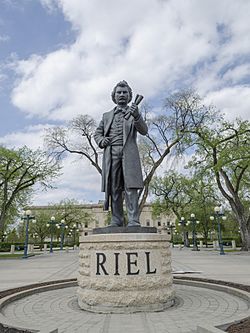Louis Riel (sculpture) facts for kids
Quick facts for kids Riel |
|
|---|---|
 |
|
| Artist | Miguel Joyal |
| Year | 1996 |
| Medium | Bronze sculpture |
| Subject | Louis Riel |
| Dimensions | 3.5 m (11 ft) |
| Location | Manitoba Legislative Building grounds, Winnipeg, Manitoba, Canada |
| 49°52′58″N 97°08′45″W / 49.882748°N 97.145915°W | |
| Other details | |
| Cost | $200,000 CAD |
| Commissioned by | Manitoba Metis Federation |
The Louis Riel sculpture is a special monument in Winnipeg, Manitoba. It honors Louis Riel, a very important Métis leader in Canadian history. You can find this large statue on the grounds of the Manitoba Legislative Building. It faces the Assiniboine River.
The Manitoba Metis Federation (MMF) asked for this statue to be made. The artist who created it was Miguel Joyal.
Contents
About the Louis Riel Sculpture
This impressive statue stands about 3.5 meters (11 feet) tall. It shows Louis Riel dressed in clothes from the 1800s. He wears a shirt, an overcoat, trousers, and moccasins.
Riel is shown with his fists clenched, looking strong and determined. In his left hand, he holds a piece of parchment. This represents the Manitoba Act. This important document helped create the province of Manitoba.
Why Was It Built?
The idea for the statue was to remember Louis Riel's important role in Manitoba's history. The artist, Miguel Joyal, chose Riel's clothing carefully. He added moccasins and a sash to show Riel's Métis background. The Manitoba Act highlights his leadership in the community.
The statue's strong pose was designed to show Riel's power and leadership. It reminds everyone of his fight for Métis rights.
How Much Did It Cost?
The cost to build the statue was about $200,000. The Manitoba Metis Federation and the Province of Manitoba planned to share the cost.
In 1994, the MMF needed a bit more money. So, the federal government helped out by giving $15,000.
How the Sculpture Was Made
Creating such a large statue is a big job! It took many steps to bring the Louis Riel sculpture to life.
From Model to Bronze
First, in April 1995, the artist Miguel Joyal made a small model of Riel. This small model is called a maquette. It took him about two weeks to create.
Once the small model was approved, the real work began. The bronze statue was made in Toronto at a special art foundry. A foundry is a place where metal is melted and shaped.
Building the Frame
The first step was to build a strong steel frame inside. This frame was like the skeleton of the statue. It held up the main parts, like the legs, arms, and head.
The frame was put on a portable base with wheels. A wooden structure was built around it. This allowed the sculptor to reach all parts of the statue easily.
Shaping the Figure
Next, large blocks of foam were glued to the steel frame. Smaller pieces of foam were added to fill out the shape. The artist divided both the small model and the foam frame into equal parts. This helped him make sure the large statue had the correct proportions.
Different types of saws were used to carve Riel's figure out of the foam. After the carving was done, a type of plaster called winterstone was put on the foam. This happened on October 26, 1995.
Casting the Bronze
Because the sculpture was very large (over 16 feet tall!), it couldn't be made in one piece. It was divided into ten sections.
Each section was made using a method called sand casting. This involves using sand mixed with a special material to create molds. The sand molds were shaped like the outer part of the statue.
Inside each sand mold, a thin layer of plasticine was added. Then, another sand mold was made over the plasticine. This created an empty space between the two sand molds. This empty space was where the melted bronze would go.
To prevent air bubbles, air vents were put in before the bronze was poured. Once the bronze cooled, the ten sections were carefully welded together. Then, the sculpture was cleaned and given a smooth texture.
Finally, a special coating called a patina was put on the bronze. This coating helps protect the statue from weather and keeps it looking good outdoors.
Moving and Installing
After it was finished, the large sculpture traveled from Toronto to Winnipeg in a big wooden crate.
It was then attached to its base using strong epoxy cement and stainless steel pins. The base itself was already installed on site. It is six feet tall and covered with Tyndall Stone, a type of stone found in Manitoba.

